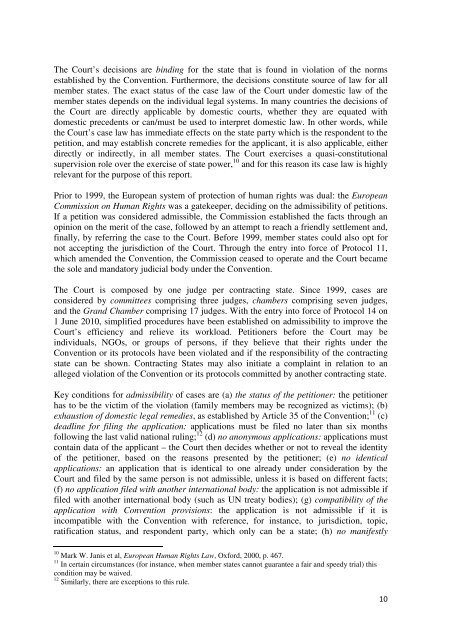Johanna Westeson - The ICHRP
Johanna Westeson - The ICHRP
Johanna Westeson - The ICHRP
You also want an ePaper? Increase the reach of your titles
YUMPU automatically turns print PDFs into web optimized ePapers that Google loves.
<strong>The</strong> Court’s decisions are binding for the state that is found in violation of the norms<br />
established by the Convention. Furthermore, the decisions constitute source of law for all<br />
member states. <strong>The</strong> exact status of the case law of the Court under domestic law of the<br />
member states depends on the individual legal systems. In many countries the decisions of<br />
the Court are directly applicable by domestic courts, whether they are equated with<br />
domestic precedents or can/must be used to interpret domestic law. In other words, while<br />
the Court’s case law has immediate effects on the state party which is the respondent to the<br />
petition, and may establish concrete remedies for the applicant, it is also applicable, either<br />
directly or indirectly, in all member states. <strong>The</strong> Court exercises a quasi-constitutional<br />
supervision role over the exercise of state power, 10 and for this reason its case law is highly<br />
relevant for the purpose of this report.<br />
Prior to 1999, the European system of protection of human rights was dual: the European<br />
Commission on Human Rights was a gatekeeper, deciding on the admissibility of petitions.<br />
If a petition was considered admissible, the Commission established the facts through an<br />
opinion on the merit of the case, followed by an attempt to reach a friendly settlement and,<br />
finally, by referring the case to the Court. Before 1999, member states could also opt for<br />
not accepting the jurisdiction of the Court. Through the entry into force of Protocol 11,<br />
which amended the Convention, the Commission ceased to operate and the Court became<br />
the sole and mandatory judicial body under the Convention.<br />
<strong>The</strong> Court is composed by one judge per contracting state. Since 1999, cases are<br />
considered by committees comprising three judges, chambers comprising seven judges,<br />
and the Grand Chamber comprising 17 judges. With the entry into force of Protocol 14 on<br />
1 June 2010, simplified procedures have been established on admissibility to improve the<br />
Court’s efficiency and relieve its workload. Petitioners before the Court may be<br />
individuals, NGOs, or groups of persons, if they believe that their rights under the<br />
Convention or its protocols have been violated and if the responsibility of the contracting<br />
state can be shown. Contracting States may also initiate a complaint in relation to an<br />
alleged violation of the Convention or its protocols committed by another contracting state.<br />
Key conditions for admissibility of cases are (a) the status of the petitioner: the petitioner<br />
has to be the victim of the violation (family members may be recognized as victims); (b)<br />
exhaustion of domestic legal remedies, as established by Article 35 of the Convention; 11 (c)<br />
deadline for filing the application: applications must be filed no later than six months<br />
following the last valid national ruling; 12 (d) no anonymous applications: applications must<br />
contain data of the applicant – the Court then decides whether or not to reveal the identity<br />
of the petitioner, based on the reasons presented by the petitioner; (e) no identical<br />
applications: an application that is identical to one already under consideration by the<br />
Court and filed by the same person is not admissible, unless it is based on different facts;<br />
(f) no application filed with another international body: the application is not admissible if<br />
filed with another international body (such as UN treaty bodies); (g) compatibility of the<br />
application with Convention provisions: the application is not admissible if it is<br />
incompatible with the Convention with reference, for instance, to jurisdiction, topic,<br />
ratification status, and respondent party, which only can be a state; (h) no manifestly<br />
10 Mark W. Janis et al, European Human Rights Law, Oxford, 2000, p. 467.<br />
11 In certain circumstances (for instance, when member states cannot guarantee a fair and speedy trial) this<br />
condition may be waived.<br />
12 Similarly, there are exceptions to this rule.<br />
10
















